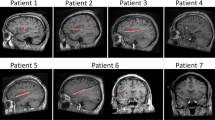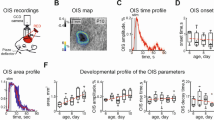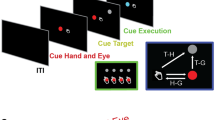Abstract
POSITRON emission tomography (PET) measurements of brain blood flow were used to monitor changes in the human primary and secondary somatosensory cortices during the period when somatosensory stimuli were expected. In anticipation of either focal or innocuous touching, or localized, painful shocks, blood flow decreased in parts of the primary somatosensory cortex map located outside the representation of the skin area that was the target of the expected stimulus. Specifically, attending to an impending stimulus to the fingers produced a significant decrease in blood flow in the somatosensory zones for the face, whereas attending to stimulation of the toe produced decreases in the zones for the fingers and face. Decreases were more prominent in the side ipsilateral to the location of the expected stimulus. No significant changes in blood flow occurred in the region of the cortex representing the skin locus of the awaited stimulation. These results are concurrent with a model of spatial attention in which potential signal enhancement may rely on generalized suppression of background activity1.
This is a preview of subscription content, access via your institution
Access options
Subscribe to this journal
Receive 51 print issues and online access
$199.00 per year
only $3.90 per issue
Buy this article
- Purchase on Springer Link
- Instant access to full article PDF
Prices may be subject to local taxes which are calculated during checkout
Similar content being viewed by others
References
Whang, K. C., Burton, H. & Shulman, G. L. Percept. Psychophys. 50, 157–165 (1991).
Fox, P. T., Burton, H. & Raichle, M. E. J. Neurosurg. 67, 34–43 (1987).
Nelson, R. J., Sur, M., Felleman, D. J. & Kaas, J. H. J. comp. Neurol. 192, 611–643 (1980).
Spielberger, C. D., Gorsuch, R. L. & Lushene, R. E. Manual for the State-Trait Anxiety Inventory (Consulting Psychologists Press, Palo Alto, CA, 1970).
Drevets, W. C., Videen, T. O., MacLeod, A. K., Haller, J. W. & Raichle, M. E. Science 256, 1696 (1992).
Burton, H., Videen, T. O. & Raichle, M. E. Somatosens. Motor Res. 10, 297–308 (1993).
Fox, P. T. & Mintun, M. A. J. nucl. Med. 30, 141–149 (1989).
Talairach, J. & Tournoux, P. Co-Planar Stereotaxic Atlas of the Human Brain, 1–122 (Thieme, Stuttgart, 1988).
Roland, P. E. J. Neurophysiol. 46, 744–754 (1981).
Chapin, J. K. & Woodward, D. J. Expl Neurol. 78, 654–669 (1982).
Chapin, J. K. & Woodward, D. J. Expl Neurol. 78, 670–684 (1982).
Chapman, C. E., Jiang, W. & Lamarre, Y. Expl Brain Res. 72, 316–334 (1988).
Chapman, C. E. & Ageranioti-Bélanger, S. A. Expl Brain Res. 87, 319–339 (1991).
Sinclair, R. J. & Burton, H. J. Neurophysiol. 66, 153–169 (1991).
Posner, M. I. & Petersen, S. E. A. Rev. Neurosci. 13, 25–42 (1990).
Coquery, J. M., Malcuit, G. & Coulmance, M. C. r. Soc. Biol. (Paris) 165, 1946–1951 (1971).
Coquery, J. M. in Active Touch (ed. Gordon, G.) 161–169 (Pergamon, Oxford, 1978).
Chapman, C. E. Bushnell, M. C., Miron, D., Duncan, G. H. & Lund, J. P. Expl Brain Res. 68, 516–524 (1987).
Sathian, K. & Burton, H. Percept. Psychophys. 50, 237–248 (1991).
Fox, P. T., Perlmutter, J. S. & Raichle, M. E. J. comput. assist. Tomogr. 9, 141–153 (1985).
Herscovitch, P., Markham, J. & Raichle, M. E. J. nucl. Med. 14, 782–789 (1983).
Raichle, M. E., Martin, W. R. W., Herscovitch, P., Mintun, M. A. & Markham, J. J. nucl. Med. 24, 790–798 (1983).
Fox, P. T., Mintun, M. A., Reiman, E. M. & Raichle, M. E. J. cerebral Blood Flow Metab. 8, 642–653 (1988).
Yamamoto, M., Ficke, D. C. & Jer-Pogossian, M. IEEE Trans. nucl. Sci. 29, 529–533 (1982).
Author information
Authors and Affiliations
Rights and permissions
About this article
Cite this article
Drevets, W., Burton, H., Videen, T. et al. Blood flow changes in human somatosensory cortex during anticipated stimulation. Nature 373, 249–252 (1995). https://doi.org/10.1038/373249a0
Received:
Accepted:
Issue Date:
DOI: https://doi.org/10.1038/373249a0
This article is cited by
-
White matter microstructural changes in short-term learning of a continuous visuomotor sequence
Brain Structure and Function (2021)
-
The Erogenous Mirror: Intersubjective and Multisensory Maps of Sexual Arousal in Men and Women
Archives of Sexual Behavior (2020)
-
Neuroimaging of neuropathic pain: review of current status and future directions
Neurosurgical Review (2018)
-
GABAA Receptors Predict Aversion-Related Brain Responses: An fMRI-PET Investigation in Healthy Humans
Neuropsychopharmacology (2013)
-
Altered networks in bothersome tinnitus: a functional connectivity study
BMC Neuroscience (2012)
Comments
By submitting a comment you agree to abide by our Terms and Community Guidelines. If you find something abusive or that does not comply with our terms or guidelines please flag it as inappropriate.



